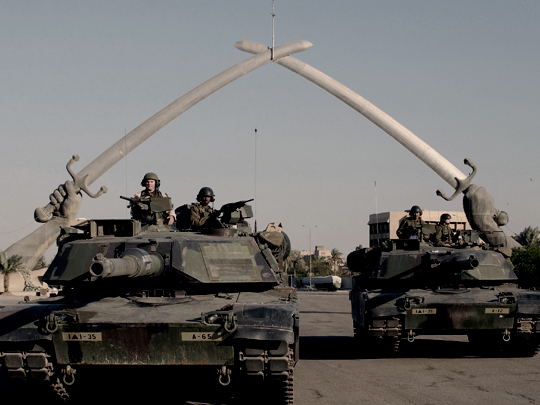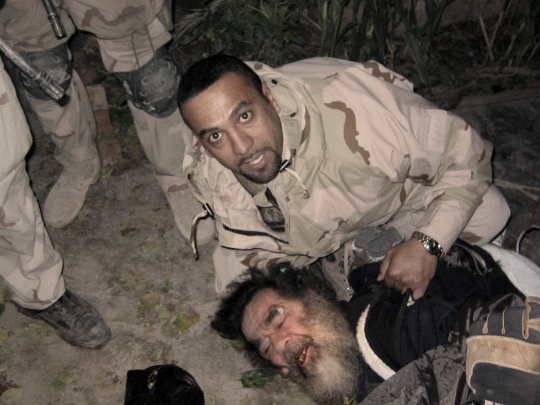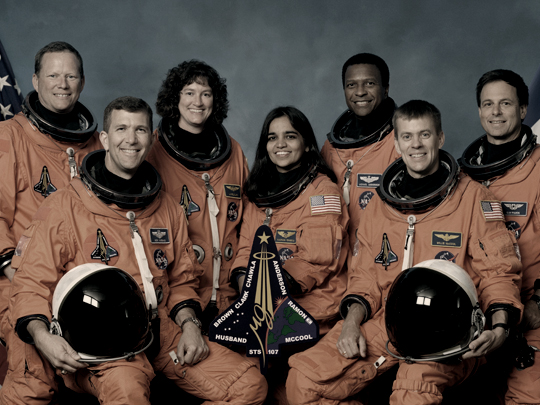NASA / Wikimedia Commons / CC-BY-SA-3.0 / GFDL
1 – Space Shuttle Columbia Disaster
On 1 February 2003, the Space Shuttle Columbia disintegrated upon re-entering Earth’s atmosphere, killing all seven crew members on board.
The disaster was the second fatal accident in the Space Shuttle program after Challenger broke apart, also killing the seven-member crew, 73 seconds after liftoff in 1986.
During the launch of Columbia‘s 28th mission, a piece of foam insulation broke off from the Shuttle’s external tank, striking its left wing.
Some engineers suspected the damage to Columbia was more serious. NASA managers limited the investigation, reasoning that the crew could not have fixed the problem if it had been confirmed.
When Columbia re-entered the Earth’s atmosphere, the damage it had sustained allowed hot atmospheric gases to penetrate the heat shield and destroy the internal wing structure, causing the spacecraft to break apart.
The crew consisted of six Americans, Rick D. Husband, William C. McCool, Michael P. Anderson, Kalpana Chawla, David M. Brown, Laurel Blair Salton Clark, and Ilan Ramon, the first Israeli astronaut.
After the disaster, Space Shuttle flight operations were suspended for more than two years, with further construction of the International Space Station also put on hold.
A number of operational changes were made, including an on-orbit inspection to determine how well the shuttle’s thermal protection system had endured take-off and having a rescue mission ready in case irreparable damage was found.
Except for a last repair mission to the Hubble Space Telescope, all later shuttle missions were only to the International Space Station.
This ensured the crew could use it as a haven in case orbiter damage prevented safe reentry.
2 – The Invasion of Iraq

The invasion of Iraq began on 20 March 2003, lasting just over one month, including 21 days of major combat operations. The invading forces were from the United States, the United Kingdom, Australia, and Poland.
The stated aim of U.S. President George W. Bush and U.K. Prime Minister Tony Blair was to seize Iraq’s weapons of mass destruction, ending Saddam Hussein’s support for terrorism, and to free the Iraqi people.
The invasion was strongly opposed by long-standing U.S. allies, including France, Germany, and New Zealand. They stated there was no evidence of weapons of mass destruction and could not justify invading Iraq.
A month before the invasion, in February 2003, there were protests around the world against the Iraq War. It is estimated up to 36 million people took part in nearly 3,000 protests across the world against the war.
Nevertheless, over 175,000 troops invaded Iraq, with approx. 130,000 from the United States, about 45,000 British soldiers, 2,000 Australian soldiers, and 194 Polish soldiers.
The invasion was preceded by an airstrike on Baghdad’s Presidential Palace in Baghdad, while massive airstrikes across the country caused chaos amongst the defending Iraqi army and prevented an effective resistance.
On 9 April, the coalition successfully occupied Baghdad, followed by the occupation of Kirkuk on 10 April, and the capture of Tikrit on 15 April.
On 1 May 2003, the end of major combat operations was announced by U.S. President George W. Bush.
The Coalition Provisional Authority was established, this being the first of several transitional governments prior to the Iraqi parliamentary election in January 2005.
Iraqi president Saddam Hussein went into hiding as the coalition forces completed the occupation of the country.
It was not until 2011, long after his capture in 2003, that occupying U.S. forces withdrew from Iraq.
3 – Saddam Hussein is Captured

On 13 December 2003, the American military conducted Operation Red Dawn in the town of Ad-Dawr, near Tikrit, in Iraq, which led to the capture of Iraqi dictator Saddam Hussein.
The operation was named after the 1984 film Red Dawn, in which the United States is invaded by the Soviet Union, Cuba, and Nicaragua.
Hussein was labeled as “High-Value Target Number One” by the U.S. military, leading to one of the largest manhunts in history.
He had disappeared shortly after the beginning of the Iraq invasion in March 2003. The military carried out numerous unsuccessful raids and interrogations to find Hussein.
In December 2003, a former driver divulged the name of Saddam’s bodyguard, Muhammed Ibrahim Omar al-Musslit, leading to his capture becoming a crucial part in the hunt for Saddam.
On 12 December 2003, a raid on an insurgent headquarters in Baghdad captured al-Musslit. The following morning, he revealed where Saddam may be found, a remote farm compound south of Tikrit.
The following morning, the U.S. joint operations Task Force searched two sites outside the town of ad-Dawr. The search eventually led to the capture of Hussein, who had been hiding in a spider hole in the ground.
A disheveled Hussein did not resist capture as he emerged from his hiding place. The operation was successfully carried out without any casualties.
Following his capture, Saddam’s trial took place under the Iraqi Interim Government.
On 5 November 2006, he was convicted by an Iraqi court of crimes against humanity, and sentenced to death by hanging. He was executed on 30 December 2006.
4 – The Human Genome Project

The Human Genome Project was an international scientific research project with the goal of determining the sequence of base pairs that make up human DNA.
The project also identified and mapped all of the genes of the human genome from both a physical and a functional standpoint. It remains the world’s largest collaborative biological project.
Most of the sequencing was performed in twenty universities and research centers across the United States, the United Kingdom, Japan, France, Germany, and China.
The project was declared complete on 14 April 2003, two years earlier than had been projected when it was undertaken.
Planning for the project started when the idea was picked up by the US government during the mid-1980s. In 1990, the project formally launched after the U.S. Congress approved $3 billion in funding.
The funding came from the US government through the National Institutes of Health, as well as numerous other groups from around the world.
The Human Genome Project aimed to map the more than three billion nucleotides contained in a human haploid reference genome.
The genome of any person is unique, with mapping involving the sequencing of a small number of individuals. They then assembled them together to get a complete sequence for each chromosome, making the finished human genome is a mosaic.
5 – Asian Bird Flu Outbreak
The global spread of highly pathogenic H5N1 influenza in birds is considered a significant pandemic threat, with tens of millions of birds dying from it and hundreds of millions more having been slaughtered to limit the spread of H5N1.
In 2003 the first cases in humans since 1997 were diagnosed, when three people in one family were infected after visiting Fujian province in mainland China. Two of the people died subsequently.
In December 2003, animals in a Thai zoo died after eating infected chicken carcasses, while the H5N1 infection was also detected in three flocks in South Korea.
In January 2004, a major new outbreak of H5N1 surfaced in Vietnam and Thailand’s poultry industry, spreading to the surrounding countries and regions, including Indonesia, South Korea, Japan, and China, within weeks.
In October 2004, researchers discovered H5N1 was far more dangerous than previously believed because waterfowl, especially ducks, were directly spreading H5N1 to chickens, crows, pigeons, other birds, and that it was increasing its ability to infect mammals as well.
In January 2005, an outbreak of avian influenza-affected around half of the cities and provinces in Vietnam, leading to the forced killing of nearly 1.2 million poultry. Up to 140 million birds are believed to have died or been killed because of the outbreak.
In April 2005, there was an unprecedented die-off of over 6,000 migratory birds in central China, with the strain later spreading to Kazakhstan, Mongolia, and Russia.
On 29 September 2005, David Nabarro, the UN Coordinator for Avian and Human Influenza, warned the world that an outbreak of avian influenza could kill 5 to 150 million people.
In the first two months of 2006 H5N1 spread to other Asian countries, North Africa, and Europe in wild bird populations.
Scientists concluded that containment had failed due to the role of wild birds in transmitting the virus.
As of July 2008, H5N1 pathogenicity is continuing to gradually rise in endemic areas but the avian influenza disease situation in farmed birds is being held in check by vaccination.
